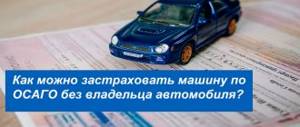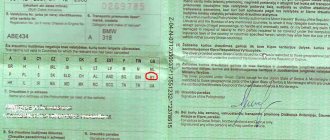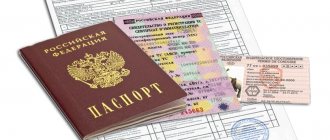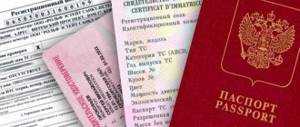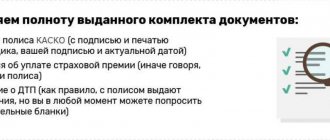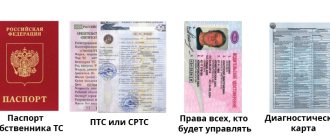This type of insurance allows you to pay for damages after most accidents. Despite this, not all drivers know in detail how compulsory motor liability insurance works in case of an accident. Our review will eliminate gaps in knowledge and allow better on-the-spot guidance in situations that are considered critical.
In fact, this insurance is mandatory for all drivers (with the exception of owners of vehicles traveling at speeds up to 20 km/h) - this policy covers motor third-party liability. If a citizen does not insure his car and turns out to be the culprit of the accident, then the insurance compensation will not be paid. Thus, OSAGO is intended to pay monetary compensation to the injured innocent party to compensate for damage caused to health, life or property. Expenses arising as a result of an accident are paid by the insurance company of the person responsible for the accident; the driver himself does not make payments. Currently, the maximum amounts provided for this policy are established:
- 400 thousand rubles for compensation of property damage;
- 500 thousand rubles for compensation for damage to the health and life of a participant in an accident (the amount is indicated per person).
Compensation for moral damage or lost profits is not provided under compulsory motor liability insurance.
Attention! If insurance does not cover the full cost of the damage, the victim may file a lawsuit against the person responsible for the incident. The offender will pay the remaining amount from his own funds.
There are situations when the insurance company may refuse to pay:
- The driver was a person not included in the insurance. An exception is insurance issued for an unlimited number of persons.
- The accident occurred at a specialized site during an experimental or training activity.
- The accident occurred on the territory of the enterprise while performing loading and unloading operations or while an employee was performing his job duties.
If the driver did not have the right to drive the car, caused harm intentionally, was under the influence of alcohol, drugs or toxic substances, or fled the scene of the accident, the insurance is still paid, but the insurer can go to court and recover the costs incurred from the culprit.
An advantageous offer from the partners of our portal - Terem Loan! Apply for a loan in the amount of up to 30 thousand rubles for a period of up to 30 days. 100% approval!
Get money
What is insurance and when does it pay out?
CASCO is voluntary insurance of the policyholder's car, while OSAGO is insurance of liability to third parties.
If you have a CASCO policy, the insured has the right to receive financial compensation for the following types of accidents:
- colliding with a vehicle and causing significant damage;
- colliding with obstacles, such as an open door;
- being damaged by an object thrown from under the wheels of another car;
- receiving damage as a result of hitting a curb, a parked vehicle, a nail or other obstacles;
- falling into a ditch or ravine.
If you have a CASCO policy, the damage is compensated even when the policyholder himself is the culprit of the accident.
What should participants do?
Participants in a traffic accident need to act competently in the event of an emergency, namely:
- stop the vehicle and turn on the hazard lights;
- display an emergency stop sign to indicate the occurrence of an accident;
- if someone is injured as a result of a traffic accident, it is necessary to provide first aid and call an ambulance;
- call the traffic police;
- report the accident to your insurance company;
- independently document damage using photographs and videos;
- together with the traffic police officers, take part in drawing up the protocol.
Under no circumstances should you leave the scene of an accident! Such an action entails punishment in the form of deprivation of the right to drive a vehicle for a period of 1 to 1.5 years or administrative arrest for a period of up to 15 days (Clause 2 of Article 12.27 of the Code of Administrative Offenses of the Russian Federation “Failure to fulfill duties in connection with a traffic accident” ).
What is an accident notification and when is it needed?
An accident always causes property damage, even if only minor scratches are left from the collision of vehicles. In case of minor damage, the parties can part ways amicably by issuing a receipt and transferring money for repairs. However, the official procedure for registering an accident involves filling out a notice.
Since Russia has a compulsory car insurance program, the priority option for damage compensation is compulsory motor liability insurance. To receive compensation you need to confirm to the insurance company:
- occurrence of an insured event, i.e. Road accident with car damage;
- all the circumstances of the accident, with a description of visible damage, the location of the first impact, the trajectory of movement, and other important facts;
- information about the participants in the accident, including the culprit of the accident;
- place and time of the incident, other essential data.
Note! Law No. 40-FZ obliges participants in an accident to immediately notify their insurance company about the accident. Even if the insurer sends a representative to the site, drivers are still required to fill out a notice. However, with the help of the insurance company's traffic commissioners, this is easier to do.
You can start filling out the form after complying with the obligations specified in the traffic rules. This list includes providing primary and emergency assistance to victims, displaying emergency signs, and a number of other actions. It is also prohibited to leave the scene of an accident until the participants have completed all formalities, including signing the notice.
What the law says
The requirement to issue notices after an accident is specified not only in Law No. 40-FZ. To assign and pay compensation under compulsory motor liability insurance, Regulations of the Central Bank of Russia No. 431-P are applied. This document also requires that a notice be drawn up, signed by the parties to the accident, and submitted to the insurance company for verification.
In 2021, the Law on Compulsory Motor Liability Insurance will be supplemented with a new norm. In addition to the standard option with written notifications, you can use the RSA mobile application. To fill out an accident report electronically, you need to consider the following points:
- the mobile application must be installed on the phones of both participants in the accident;
- The electronic format of the form is allowed only according to the Europrotocol scheme, i.e. if there are no casualties, several other conditions are met;
- You need to confirm the signature on the electronic form through the government services portal, and you can transfer the data to the insurer only if you have Internet access.
Since the ability to fill out and submit a notice in digital format is not yet available in all constituent entities of the Russian Federation, below we will analyze the standard rules for filling out.
Deadline for applying to the Investigative Committee
After an accident has occurred and a traffic police officer has recorded it and drawn up a report, you must contact your CASCO insurance company as soon as possible.
As a rule, the application period is specified in the contract for the CASCO policy. Each insurance company sets its own deadlines for claims after an accident; Some insurance companies require immediate notification of the incident, while other insurance companies set a deadline within which to contact, for example, 4 business days.
If the contract for the CASCO policy does not provide for a clause regarding the timing of claims after an accident, then by law the policyholder must submit an application no later than 5 days from the date of the accident.
What to do if the culprit refuses to compensate for the damage
Drivers who have traffic problems often do not admit the fact of non-compliance with traffic rules. If the offender refuses to compensate for the damage, there is an algorithm of actions for the victim:
- Call the traffic police officer and record the emergency.
- Contact the insurer of the person responsible for the accident.
- Conduct an examination when receiving a refusal to pay from the company.
- File a pre-trial claim in the name of the violator.
- File a claim with a higher authority if compensation for damage is refused.
When going to court, the victim must provide evidence of the demands made, violation of traffic rules by the defendant. If compensation for road accident damage is not paid from the culprit, the plaintiff has the right to submit a second application to a higher authority. The statute of limitations for civil cases is 3 years.
Procedure in case of an accident
When a traffic accident occurs, it is very important to do everything correctly and in a certain sequence:
- First of all, a traffic police officer is called to the scene of the incident to draw up a report on the incident and identify the person responsible.
- Within 5 days from the date of the incident or another period specified in the CASCO policy agreement, you must contact the insurance company to report an accident with the insured car.
- At the request of the insurance company, provide the damaged car for an appraisal examination and receive the results of its conclusion.
- If you disagree with the results of the examination carried out by the insurance company, you need to independently conduct an independent examination of the vehicle.
- Submit an application to the insurance organization for compensation for the insured event under CASCO, attaching the necessary documents.
In what case will the insurance company refuse to pay?
When determining whose insurance company will compensate for damages to a victim in an accident, the participant in the accident provides documents to receive compensation. But companies may refuse to pay. Reasons for not satisfying the request:
- submission of documents later than the established deadlines;
- expired MTPL;
- payment of compensation at the scene of an accident;
- car repair before examination;
- damage to the vehicle not due to an emergency;
- driving by a citizen who is not included in the insurance policy;
- unknown culprit of the accident;
The company may also refuse payment if the victim provided an incomplete list of documents. Drivers are given 20 days to submit an application once an accident is recorded by a traffic police inspector. If the company has lost its license at the time of the victim’s application, compensation is provided from the funds of the Russian Union of Auto Insurers.
Advice! In the event of a collision between two cars, there is no danger to the life and health of citizens, and there are valid compulsory motor liability insurance policies, the injured participant must contact his own insurer.
In other cases, payments are made by the company responsible for the incident. If it is impossible to independently resolve the conflict, the victim can file an application with the court.
Necessary documents for registration
When contacting an insurance company to receive compensation under CASCO as a result of an accident, you must provide the following documents:
- application for payment of compensation for damage suffered;
- passport and contact details of the applicant;
- CASCO insurance policy;
- the applicant's driver's license;
- vehicle inspection certificate, registration certificate or vehicle passport;
- traffic accident report indicating damage and a certificate from the traffic police;
- medical report on victims of the accident, if any;
- if the contract specifies a clause on payment for related services, then provide receipts or checks for payment for tow truck, parking, etc.
Statement about the occurrence of an insured event
An application for CASCO insurance in case of an accident can be completed in any form or on the letterhead provided by the insurance company.
Regardless of the form of completion, the application must indicate mandatory data, such as:
- name, address and contact information of the insurance organization;
- contact and passport details of the applicant;
- CASCO policy number and date of its conclusion;
- complete information about the insured vehicle;
- detailed description of the insurance case: time, date, place, cause and participants of the accident;
- detailed description of vehicle damage;
- presence of traffic police officers at the scene of an accident;
- demands to the insurance company for reimbursement of material compensation for the restoration of the vehicle;
- indication of bank details for the transfer of compensation;
- list of attached copies of documents;
- date of application and signature of the applicant.
Application processing and payment deadlines
Like the deadline for filing, the deadline for considering an application for payment of insurance compensation must be specified in the contract for the CASCO policy. If there is no such clause in the contract, then you should check with the insurance company about the possible review period.
It is worth noting that the standard period for consideration of an application is from 5 to 14 days. If there is a lack of information or documents, the period can be extended by no more than 30 days.
The timing of payment of money also does not have clear boundaries and must be specified in the contract or discussed by the insurer.
But there are average payment terms from different insurance companies:
- Insurance companies with a client base of more than 1 million clients – up to 14 days;
- Insurance companies with a base of 50 thousand to 1 million clients – up to 30 days;
- Insurance companies with a number of clients from 5 to 50 thousand clients can pay either within a week or not pay until the client demands it in a legal form;
- Unknown insurance companies are, as a rule, scammers, and you should not expect compensation from them.
How does CASCO work if the applicant is at fault?
If the applicant is the culprit of the accident, then, as in the opposite situation, the policy will cover all the necessary costs for restoring the car.
But it is worth remembering that if at the time of the accident the culprit-applicant was under the influence of alcohol or drugs, grossly violated traffic rules or intentionally caused damage to the car in order to receive compensation, then the CASCO insurance company has the right to refuse insurance payment.
Reasons for refusal
It is no secret that insurance companies are looking for reasons to refuse insurance payment. Such an action is possible, but only in certain situations specified in the policy agreement, namely:
- the applicant seriously violated traffic rules, thereby causing an accident;
- after the accident, the applicant did not act in accordance with traffic rules or left the scene of the accident;
- the driver of the vehicle did not have a driver’s license;
- the applicant drove the car while under the influence of alcohol or drugs;
- the driver did not complete documents at the scene of the accident;
- the application for damages and the required documents were submitted after the period specified in the policy without a valid reason;
- the accident report does not indicate the applicant’s claims;
- the damage to the car was caused intentionally for profit;
- the terms of the CASCO agreement were violated;
- the driver repaired the vehicle before contacting the insurance company and conducting an examination.
A traffic accident can happen to any motorist. In order to protect your car as much as possible and receive financial compensation for damage caused, insurance companies offer to purchase a CASCO policy.
To receive an insurance payment, it is important to act correctly in the event of an accident, contact the insurance company in a timely manner, providing the necessary documents, and clearly know your rights. Good luck on the roads!
Main principles of MTPL insurance
MTPL insures your driving behavior: if the accident is your fault, the damage to those injured in the accident will be compensated from the insurance company's funds within the insurance limits. For the injured party, having insurance is a guarantee that the damage caused will be compensated in any case.
Another principle of MTPL insurance is the presence of a guilty and injured party. This is mandatory to establish an insured event. OSAGO insures liability on the road. If there are no perpetrators and victims, then there is no fact of liability. In such a situation, insurance does not work.
Example 1: a car skidded on an icy road and ended up in a ditch. There is a victim, but there are no perpetrators - this is not an insured event. If this car touches other vehicles or damages them, the SS is present, the insurance will be paid.
If the person responsible for the accident flees the scene of the accident, this does not mean that there is no insured event. The fact that someone is at fault for an accident is sufficient to obtain insurance.
OSAGO insurance does not cover moral damages after an accident. Only material damage is recognized as an insured event for payment.
Example 2: one car cut off another at a traffic light. The second driver braked sharply, other road users did the same behind him, and a traffic jam arose. The participants in the incident, not knowing the reason for the sudden braking, attacked the second driver with accusations of creating an emergency situation. This situation is an administrative incident. It is possible to impose a fine on the culprit, but there is no CC, since there is no damage, and insurance does not work here. The second driver can apply for compensation for moral damage, but not from the insurance company, but from the court. He will file a lawsuit against the at-fault driver.
And one more important rule - compulsory motor liability insurance does not cover the damages of the party at fault in the accident. That is, if the culprit of the accident also damaged his car, the insurance company will compensate for the damage only to the injured party. He will repair his car at his own expense. If the maximum limit of 400 thousand is not enough to cover the damage, the remaining amount is recovered from the guilty party in court.
